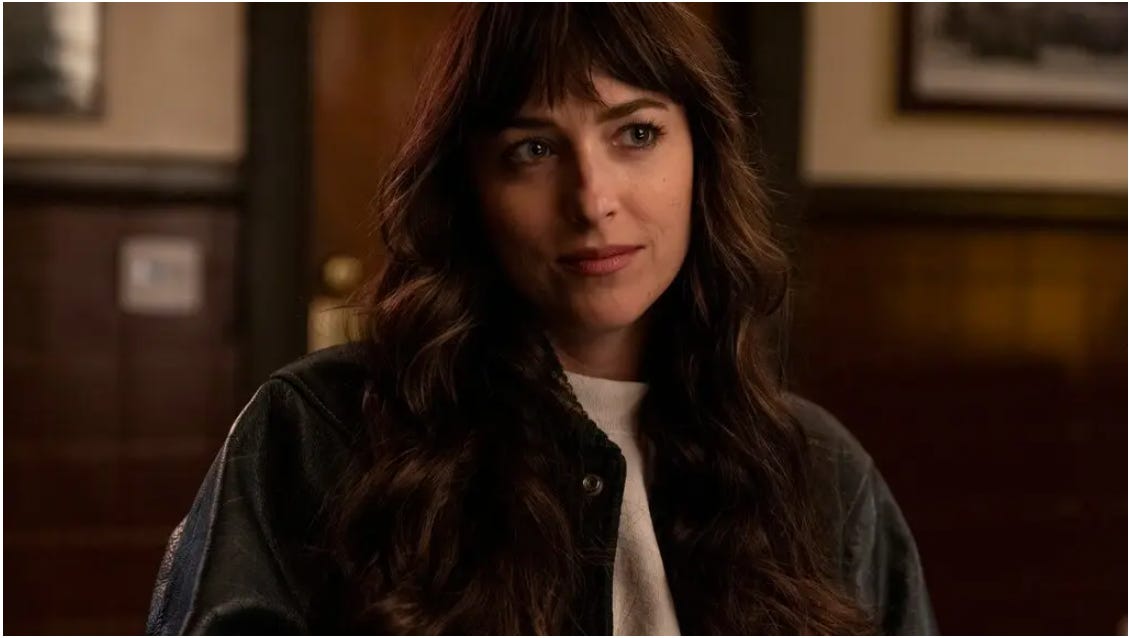am I ok?
Film, 2022
Directed: Tig Notaro and Stephanie Allynne
Written: Lauren Pomerantz
Apparently, the answer to “did we need another coming out film?” was yes, at least to first time directors Tig Notaro and Stephanie Allynne. Unfortunately, it felt seriously dated the second it landed on the streamer.
This works better as an exploration of female friendship rather than the promised quirky coming out adventure of queerness in your thirties that is in all the promos. This is an obvious marketing fail.
Jane (Sonoya Mizuno) and Lucy (Dakota Johnson) are in their early thirties and are longtime best friends (which every woman knows is the most damn well complex relationship there is). Jane is a career woman on the rise, while Lucy has sublimated her artistic talents in a dead-end job. They are each other’s opposites, but their knowledge of and love for each other is (meant to be!) profound.
When Lucy admits she is gay, it throws Jane for a loop. How could she not have known this fundamental thing about her best friend? She overcompensates by becoming the greatest, most queer-friendly advocate ever, going so far as to kiss a stranger in a gay bar (a cringey, wasted cameo from ER Fightmaster) which actually just highlights how self-centered she is. The strain of Lucy’s indecisiveness pushes their friendship to its limits.
How did they make Dakota Fanning profoundly boring? That’s a feat in itself. Lucy lives a quiet life where she orders the same food at the same diner every day, and doesn’t have the courage to pursue any of her passions. Being a lesbian is the first interesting thing she’s ever done. Lucy attempts first to date women, and then to pursue a thing with one of the massage therapists in her practice who is experimenting with being bisexual.
You’re fully permitted to scream “no! that’s the worst idea ever!” pantomime-like at the screen at this point. It is a bad idea, and not sexy at all. Dakota Johnson portrays Lucy’s discomfort by being physically clumsy, but the scenes are so overdone.
Lucy’s art is a badly disguised metaphor for sexuality and self-knowledge. As she gets to know herself, mostly off the back of her sexual awakening, her art blooms again. She quits her job (yet can still afford her fabulous, quirky little apartment! I really really hate that trope) and dives into art, finding self-expression and peace for the first time in her adult life.
Which might have been fine - but then we get the absolute stupidest storyline of the film (and there’s competition) involving Jane trying to move on from her best friend after they argue at a retreat where she’s encouraged to scream by a therapist thoroughly overplayed by Tig Notaro.
If all that sounds fairly trite, you’re not wrong. The real love story here is between the quirky best friends but if that’s the case you need to really lean into that. The banter between them is real but not funny enough. Jane’s psychology is shallow, and even their conflict is dumb. They split over basic traits they would have known perfectly well about each other if their friendship was really as strong as we’re led to believe.
If you are reading this and think you’ve seen it all before, you really have. If you’re a hardcore fan of Notaro, Johnson, or Mizuno, (Hello! Me! Dakota!) you might watch this just to say you’ve seen that odd queer film, but this is a classic case of a vanity project gone wrong.
In their earnestness to represent, they forgot that the number one thing that’s needed is a story that feels authentic to your queer audience, not playing to the (straight) cheap seats. I’ve read a lot of straight reviewers who loved this. They’re wrong.





